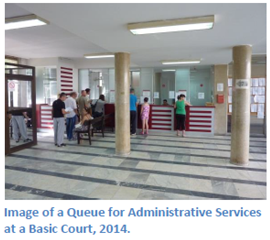Serbia Justice Functional Review
External Performance Assessment > Efficiency in the Delivery of Justice Services
f. Efficiency in the Delivery of Administrative Services314
 According to the Multi-Stakeholder Justice Survey,
more than 70 percent of court users were satisfied with the
efficiency with the administrative service they received,
including the verification or certification of documents. In
particular, there is a significant increase in satisfaction with
services relating to the verification of documents and contracts
since 2009 (see Figure 47).
According to the Multi-Stakeholder Justice Survey,
more than 70 percent of court users were satisfied with the
efficiency with the administrative service they received,
including the verification or certification of documents. In
particular, there is a significant increase in satisfaction with
services relating to the verification of documents and contracts
since 2009 (see Figure 47).
- Given these positive results, one may query what
problem the introduction of notary services was intended to
solve. Private notaries are common elsewhere in Europe.315 In
Serbia, their introduction was aimed at improving efficiency by taking from the courts a range of administrative tasks, focusing
mainly on verification.316 Private notaries are scheduled to commence in September 2014, and it would appear that private notaries will be able to compete with courts for these services. It is expected that private notary services will be faster but considerably more expensive. These

- Court users also report that the time needed to complete an administrative task has decreased. The average time needed to verify documents and contracts has been reduced from 118 minutes in 2009 to 78 minutes in 2013. In terms of other administrative tasks, the average time has been reduced from 164 minutes to 91 minutes. In 2013, 48 percent of verification services were completed within 30 minutes, and more than 40 percent of other administrative services were as well. In 2009, only 25 percent of services were completed in that time.
- However, average times hide a significant variation in the range of reported time taken to complete an administrative task. A considerable percentage of court users reported spending between 90 and 180 minutes at the court to complete their administrative task, while a further group reported that it took them even more than 10 hours. Some representatives of business sector reported to have spent a number of working days on completion of one administrative task (See Figure 48).

- Multiple visits are generally still required for a user to complete an administrative task, and this has not changed from 2009 to 2013. Court users from the public reported that their task required on average 2 to 3 visits to complete. Users from the business sector reported having to visit the court on average 3 times. However, the percentage of users who could complete their task in one visit rose from 42 to 50 percent from 2009 to 2013. For the verification of documents and contracts, 56 percent of court users reported completing their verification task during one visit in 2013, a significant improvement since 2009 (see Figure 49).

- The average time that a user spends at each visit is quite lengthy. Both general court users and business users reported that on average, the time spent to complete a task is about 39-45 minutes. Only 5 percent of court users reported that the task took from 91 to 180 minutes, compared to 32 percent in 2009. However, 15 percent reported that their task took 181 minutes to 10 hours, compared to only 5 percent for this duration in 2009.
- Court users can now more often complete their administrative task at one location, instead of going from door to door. In 2013, 74 percent of users reported completing their verification task at one location, an increase from 49 percent in 2009 (see Figure 50).

- While efficiency in administrative services has increased, there still is room for improvement. In 2013, 47 percent of general users and 41 percent of business users still report that their administrative task could have been completed in shorter time. Over 20 percent of administrative services providers agree.

- If courts and private notaries were able to compete for verification services, courts could improve timeliness in several ways. In the Multi-Stakeholder Justice Survey, 41 percent of the administrative service providers themselves noted that tasks could be completed in less time via the simplification of procedures, 38 percent pointed to better technical equipment such as computers, and 29 percent pointed to a better allocation of work and better informing of the clients. Unsurprisingly, over 60percent also suggested salary increases. From the perspective of providers, there is efficiency to be gained.
 According to the Multi-Stakeholder Justice Survey,
more than 70 percent of court users were satisfied with the
efficiency with the administrative service they received,
including the verification or certification of documents. In
particular, there is a significant increase in satisfaction with
services relating to the verification of documents and contracts
since 2009 (see Figure 47).
According to the Multi-Stakeholder Justice Survey,
more than 70 percent of court users were satisfied with the
efficiency with the administrative service they received,
including the verification or certification of documents. In
particular, there is a significant increase in satisfaction with
services relating to the verification of documents and contracts
since 2009 (see Figure 47).




